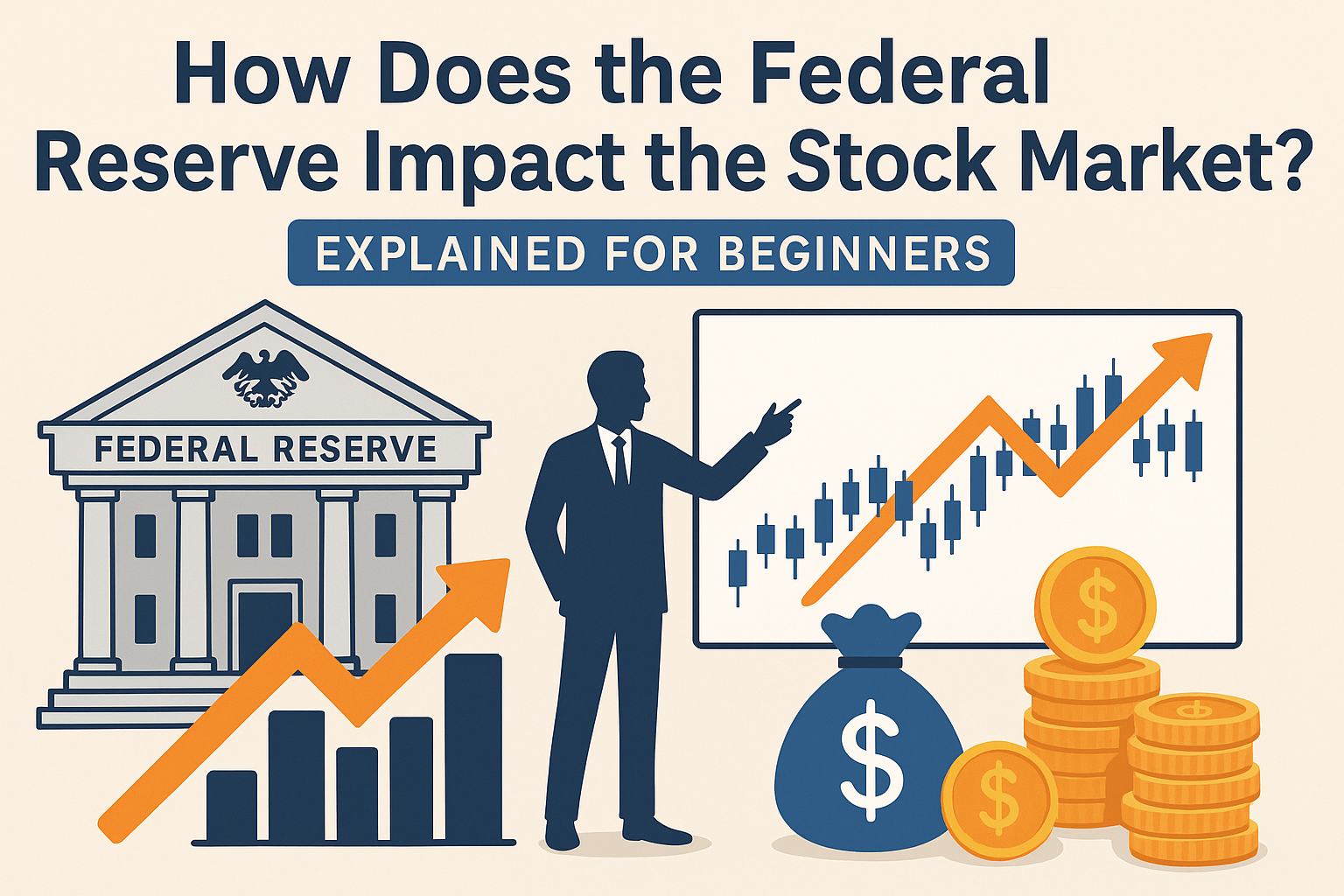Introduction
The Federal Reserve, often referred to as “the Fed,” is a powerful institution that plays a crucial role in shaping the U.S. economy—and by extension, the stock market. For new investors, understanding how the Federal Reserve’s actions influence the stock market can seem daunting. But it doesn’t have to be. In this beginner-friendly guide, we’ll break down the Federal Reserve’s role, its key tools, and how its decisions ripple through the stock market. By the end, you’ll have a clear understanding of how the Fed’s policies can affect your investments and what to watch for as a new investor.
This article is designed to be comprehensive yet accessible, diving deep into the mechanisms of the Federal Reserve while keeping things simple for beginners. We’ll also explore historical examples, practical implications for investors, and key terms to know—all while optimizing for SEO to ensure you can find this information easily. Let’s get started!
What Is the Federal Reserve?
The Federal Reserve is the central banking system of the United States, established in 1913 to provide a safer, more flexible, and stable monetary and financial system. It serves as the backbone of the U.S. economy, overseeing monetary policy, regulating banks, and maintaining financial stability. The Fed operates independently of the government but reports to Congress on its activities.
The Federal Reserve has three main objectives:
- Maximize Employment: Ensuring that as many Americans as possible have jobs.
- Stabilize Prices: Keeping inflation in check to maintain the purchasing power of the dollar.
- Moderate Long-Term Interest Rates: Promoting economic growth by ensuring borrowing costs remain reasonable.
To achieve these goals, the Fed uses a variety of tools, which we’ll explore later. For now, it’s enough to know that the Fed’s actions directly influence the economy—and the stock market.
Why Does the Federal Reserve Matter to the Stock Market?
The stock market is highly sensitive to economic conditions, and the Federal Reserve plays a major role in shaping those conditions. When the Fed makes a decision—whether it’s raising interest rates, cutting rates, or adjusting its balance sheet—it sends ripples through the economy that ultimately affect stock prices. Here’s why:
- Interest Rates and Borrowing Costs: The Fed controls the federal funds rate, which is the interest rate at which banks lend to each other overnight. Changes in this rate influence borrowing costs for consumers and businesses, impacting spending, investment, and corporate profits—all of which affect stock prices.
- Investor Sentiment: The Fed’s actions signal its outlook on the economy. For example, cutting interest rates might signal economic weakness, which could lead to uncertainty in the stock market. Conversely, raising rates might signal confidence in economic growth, boosting investor optimism.
- Inflation and Economic Growth: The Fed’s efforts to control inflation and promote growth directly impact the performance of companies in the stock market. High inflation can erode profits, while strong economic growth can boost them.
For beginners, the key takeaway is this: The Federal Reserve’s decisions create a domino effect that influences how much money flows into the stock market, how companies perform, and how investors behave.
Key Tools of the Federal Reserve
To understand how the Fed impacts the stock market, we need to look at the tools it uses to influence the economy. These tools are the levers the Fed pulls to control money supply, interest rates, and economic activity.
The Federal Funds Rate
The federal funds rate is the most well-known tool of the Federal Reserve. It’s the interest rate at which banks lend to each other overnight to meet reserve requirements. When the Fed raises or lowers this rate, it affects interest rates across the economy, including those for mortgages, car loans, and corporate borrowing.
- Raising Rates: When the Fed increases the federal funds rate, borrowing becomes more expensive. This can slow down economic activity, reduce consumer spending, and lower corporate profits, often leading to a decline in stock prices.
- Lowering Rates: When the Fed cuts rates, borrowing becomes cheaper, encouraging spending and investment. This can boost economic growth, increase corporate profits, and drive stock prices higher.
Example: In March 2020, during the COVID-19 pandemic, the Fed slashed the federal funds rate to near zero (0–0.25%) to stimulate the economy. This led to a surge in stock prices as investors anticipated cheaper borrowing and increased economic activity. You can read more about this decision on the Federal Reserve’s official website.
Open Market Operations (OMO)
The Fed also influences the economy through open market operations, which involve buying or selling government securities (like Treasury bonds) in the open market.
- Buying Securities: When the Fed buys securities, it injects money into the economy, increasing the money supply and lowering interest rates. This encourages borrowing and investment, often boosting stock prices.
- Selling Securities: When the Fed sells securities, it removes money from the economy, decreasing the money supply and raising interest rates. This can slow economic activity and lead to a decline in stock prices.
Example: During the 2008 financial crisis, the Fed launched a program called Quantitative Easing (QE), where it bought large amounts of government securities to inject money into the economy. This helped stabilize financial markets and supported a recovery in stock prices.
The Discount Rate
The discount rate is the interest rate the Fed charges banks to borrow directly from its discount window. It’s another way the Fed influences borrowing costs and liquidity in the economy.
- A lower discount rate encourages banks to borrow, increasing the money supply and stimulating economic activity.
- A higher discount rate discourages borrowing, slowing down the economy.
Reserve Requirements
Reserve requirements dictate how much money banks must hold in reserve and not lend out. While the Fed rarely changes reserve requirements, they can have a significant impact when adjusted.
- Lowering Requirements: Allows banks to lend more, increasing the money supply and stimulating economic activity.
- Raising Requirements: Forces banks to hold more in reserve, reducing lending and slowing economic growth.
Forward Guidance
Forward guidance refers to the Fed’s communication about its future policy intentions. By signaling its plans for interest rates or other actions, the Fed can influence investor expectations and market behavior.
Example: In 2023, the Fed used forward guidance to signal that it would keep interest rates high to combat inflation. This led to volatility in the stock market as investors adjusted their expectations for future economic growth.
How Federal Reserve Policies Impact the Stock Market
Now that we understand the Fed’s tools, let’s dive into how these policies directly affect the stock market. We’ll break this down into several key areas.
Interest Rates and Stock Valuations
Interest rates have a profound impact on stock valuations. When the Fed raises interest rates, the cost of borrowing increases, which can reduce corporate profits and slow economic growth. This often leads to lower stock prices, as investors reassess the future earnings potential of companies.
Conversely, when the Fed lowers interest rates, borrowing becomes cheaper, boosting corporate profits and economic growth. This typically leads to higher stock prices as investors become more optimistic about future earnings.
Practical Impact for Beginners: If you’re investing in growth stocks (like tech companies), higher interest rates can be particularly harmful because these companies often rely on borrowing to fuel expansion. On the other hand, lower interest rates can make growth stocks more attractive.
Inflation and Corporate Profits
The Fed’s efforts to control inflation also impact the stock market. Inflation erodes the purchasing power of consumers, which can lead to higher costs for companies and lower profits. If the Fed raises interest rates to combat inflation, it can slow economic growth, further pressuring corporate earnings and stock prices.
However, if the Fed allows inflation to run too high without intervention, it can lead to uncertainty in the markets, as investors worry about the long-term value of their investments.
Historical Example: In the early 1980s, the Fed, under Chairman Paul Volcker, raised interest rates dramatically to combat double-digit inflation. While this successfully curbed inflation, it also led to a recession and a sharp decline in stock prices. You can learn more about this period in a detailed analysis by the U.S. Department of the Treasury.
Investor Sentiment and Market Psychology
The Fed’s actions don’t just impact the economy—they also influence investor sentiment. When the Fed signals confidence in the economy (e.g., by raising rates), investors may feel more optimistic, driving stock prices higher. Conversely, when the Fed cuts rates or signals economic concerns, it can lead to fear and uncertainty, causing stock prices to fall.
Example: In December 2018, the Fed raised interest rates and signaled more hikes to come, leading to a sharp sell-off in the stock market as investors worried about a potential economic slowdown. The S&P 500 dropped nearly 20% in the final quarter of 2018.
Sector-Specific Impacts
The Fed’s policies don’t affect all sectors of the stock market equally. Some sectors are more sensitive to interest rate changes than others.
- Financials: Banks and financial institutions often benefit from higher interest rates because they can charge more for loans, increasing their profits.
- Technology: Tech companies, which often rely on borrowing to fund growth, tend to underperform when interest rates rise.
- Utilities: Utility stocks, which are often seen as “bond proxies” due to their high dividends, tend to decline when interest rates rise because bonds become more attractive.
Practical Tip for Beginners: If you’re building a diversified portfolio, pay attention to how the Fed’s actions might affect different sectors. For example, during periods of rising interest rates, you might consider increasing your exposure to financial stocks while reducing exposure to tech stocks.
Currency and Global Markets
The Fed’s actions also impact the value of the U.S. dollar, which can affect global markets and, in turn, the U.S. stock market. When the Fed raises interest rates, the dollar typically strengthens because higher rates attract foreign investors seeking better returns. A stronger dollar can make U.S. exports more expensive, potentially hurting companies that rely on international sales (like many in the S&P 500).
Example: In 2022, the Fed’s aggressive rate hikes led to a strong U.S. dollar, which negatively impacted multinational companies like Apple and Microsoft, as their overseas revenues took a hit when converted back to dollars.
Historical Examples of the Fed’s Impact on the Stock Market
To better understand the Fed’s influence, let’s look a few historical examples that highlight how its actions have shaped the stock market over time.
The 2008 Financial Crisis
During the 2008 financial crisis, the Fed took unprecedented steps to stabilize the economy and financial markets. It lowered the federal funds rate to near zero and launched Quantitative Easing (QE), buying trillions of dollars in government securities to inject money into the economy.
Impact on the Stock Market: The S&P 500 hit a low of 666 points in March 2009 but began a historic recovery as the Fed’s actions restored confidence in the financial system. By 2013, the S&P 500 had more than doubled from its crisis low.
The 2015–2018 Rate Hike Cycle
Between 2015 and 2018, the Fed gradually raised interest rates as the U.S. economy recovered from the Great Recession. While the stock market initially continued to rise, the Fed’s signaling of further rate hikes in late 2018 sparked fears of an economic slowdown, leading to a sharp market correction.
Impact on the Stock Market: The S&P 500 dropped nearly 20% in Q4 2018, highlighting how sensitive the market can be to the Fed’s actions.
The COVID-19 Pandemic Response (2020)
In March 2020, as the COVID-19 pandemic caused a global economic shutdown, the Fed acted swiftly. It cut the federal funds rate to near zero, launched massive QE programs, and introduced emergency lending facilities to support businesses and financial markets.
Impact on the Stock Market: After an initial crash in March 2020 (the S&P 500 fell 34% in a matter of weeks), the Fed’s actions fueled a rapid recovery. The S&P 500 ended 2020 up 16%, driven by low interest rates and increased liquidity.
What Should New Investors Watch For?
As a beginner, it can be overwhelming to keep track of the Fed’s actions and their implications for the stock market. Here are a few key things to monitor:
Federal Open Market Committee (FOMC) Meetings
The FOMC, the Fed’s policymaking body, meets eight times a year to set monetary policy. These meetings often result in announcements about interest rates, forward guidance, or other policy changes that can move the stock market.
Tip: Pay attention to the FOMC’s post-meeting statements and press conferences, which often provide insight into the Fed’s outlook. You can find the FOMC meeting schedule and statements on the Federal Reserve’s website.
Economic Indicators
The Fed bases its decisions on economic data, so it’s helpful to understand the indicators it watches closely:
- Inflation: Measured by the Consumer Price Index (CPI) or Personal Consumption Expenditures (PCE) index. High inflation often prompts the Fed to raise rates.
- Unemployment Rate: A high unemployment rate might lead the Fed to cut rates to stimulate job growth.
- GDP Growth: Strong GDP growth might prompt the Fed to raise rates to prevent the economy from overheating.
Tip: You can track these indicators through the U.S. Bureau of Labor Statistics or the Bureau of Economic Analysis.
The Fed’s Tone and Forward Guidance
The Fed’s language can be just as important as its actions. If the Fed signals that it’s worried about inflation or economic growth, it can influence investor sentiment and stock prices.
Tip: Look for keywords like “hawkish” (indicating a focus on fighting inflation, often through rate hikes) or “dovish” (indicating a focus on supporting growth, often through lower rates).
Market Reactions
The stock market often reacts immediately to Fed announcements. Pay attention to how the S&P 500, Dow Jones Industrial Average, and Nasdaq Composite respond to Fed decisions, as these indices can give you a sense of broader market sentiment.
Tip: Use financial news outlets like CNBC or Bloomberg to stay updated on market reactions.
Practical Tips for New Investors
Understanding the Fed’s impact on the stock market is only the first step. Here are some actionable tips to help you navigate its influence as a new investor:
Diversify Your Portfolio
The Fed’s actions can disproportionately affect certain sectors. By diversifying your investments across different sectors (e.g., financials, technology, consumer goods), you can reduce your risk.
Focus on Long-Term Goals
The stock market can be volatile in response to Fed actions, but short-term fluctuations often even out over time. Focus on your long-term investment goals rather than reacting to every Fed announcement.
Consider Dividend Stocks
During periods of rising interest rates, dividend-paying stocks (like those in utilities or consumer staples) can provide a steady income stream and help offset market volatility.
Stay Informed
Keep an eye on Fed announcements and economic data to understand the broader context of market movements. Knowledge is power when it comes to investing.
Don’t Panic
Market corrections and volatility are normal, especially in response to Fed actions. Avoid making impulsive decisions based on short-term market movements.
Common Misconceptions About the Fed and the Stock Market
There are several myths about the Federal Reserve and its impact on the stock market that can confuse beginners. Let’s clear up a few:
Myth 1: The Fed Directly Controls the Stock Market
While the Fed’s actions influence the stock market, it doesn’t control it. Stock prices are determined by a variety of factors, including corporate earnings, investor sentiment, and global events.
Myth 2: Lower Interest Rates Always Lead to Higher Stock Prices
While lower rates often boost stock prices, this isn’t always the case. If the Fed cuts rates because of a severe economic downturn, the stock market might still decline due to broader economic concerns.
Myth 3: The Fed Only Cares About the Stock Market
The Fed’s primary goals are to maximize employment, stabilize prices, and moderate long-term interest rates—not to prop up the stock market. While its actions often impact the market, that’s not its main focus.
Conclusion
The Federal Reserve plays a pivotal role in shaping the U.S. economy and, by extension, the stock market. Its decisions on interest rates, open market operations, and forward guidance create a ripple effect that influences borrowing costs, corporate profits, investor sentiment, and stock prices. For new investors, understanding the Fed’s actions can provide valuable insight into market movements and help you make more informed investment decisions.
By keeping an eye on FOMC meetings, economic indicators, and market reactions, you can better navigate the stock market’s ups and downs. And by focusing on diversification, long-term goals, and staying informed, you can mitigate the risks associated with Fed-driven volatility.
The stock market can be a wild ride, but with a solid understanding of the Federal Reserve’s role, you’ll be better equipped to handle the journey. Happy investing!
H2: Disclaimer
This article is for informational purposes only and does not constitute financial advice. Investing in the stock market involves risks, and you should consult with a qualified financial advisor before making any investment decisions. The information provided here is based on publicly available data and historical examples, but past performance is not indicative of future results.








